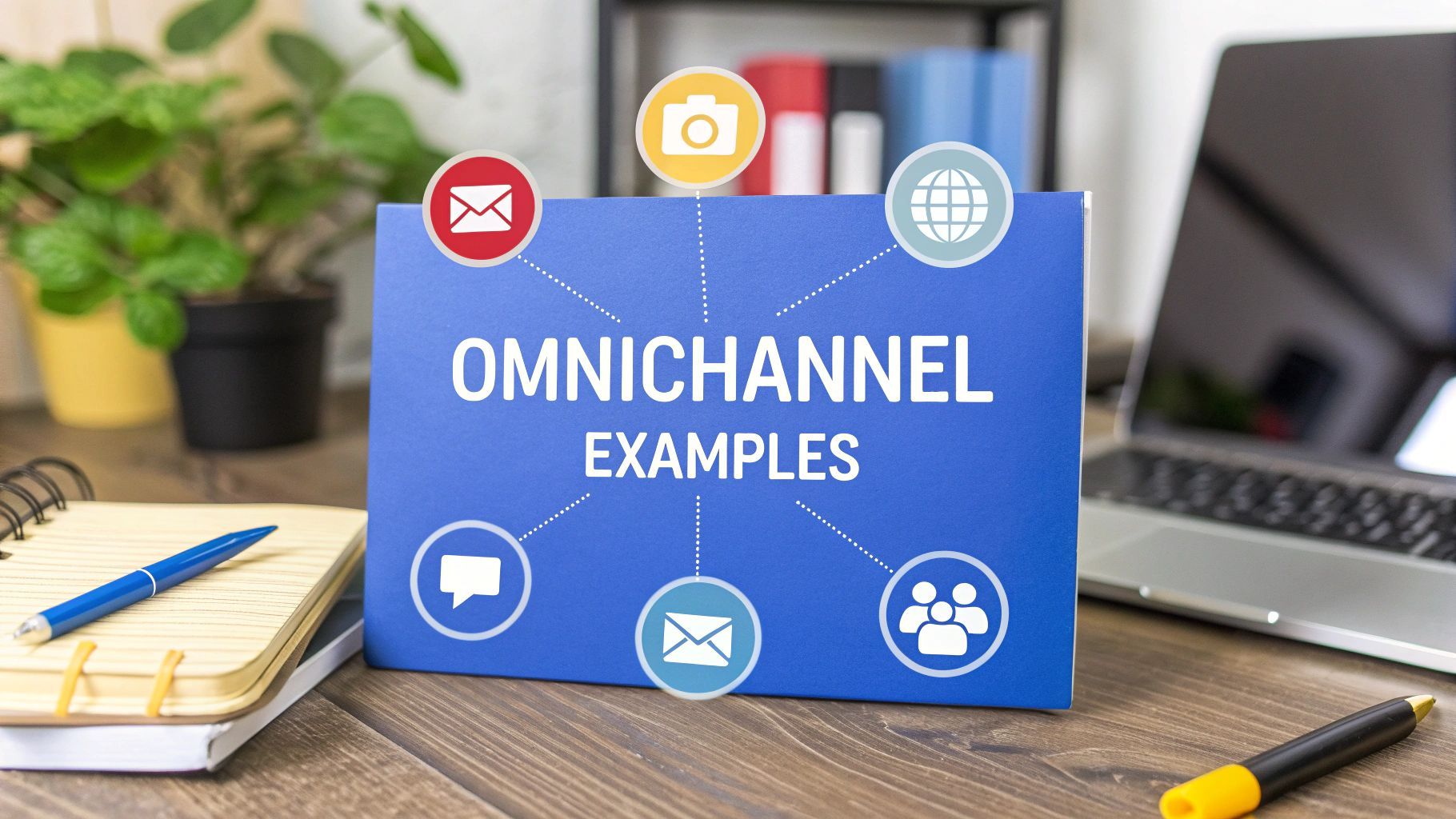
7 Omnichannel Marketing Examples to Inspire You in 2025
Discuss with AI
Get instant insights and ask questions about this topic with AI assistants.
💡 Pro tip: All options include context about this blog post. Feel free to modify the prompt to ask more specific questions!
In today's hyper-connected market, simply being present on multiple channels is not enough. Customers expect a fluid, unified experience whether they are browsing on social media, using your mobile app, or visiting a physical store. This is the core of omnichannel marketing: a holistic strategy that places the customer at the center of a cohesive brand universe, not the channel. But what does this look like in practice?
This article moves beyond theory to dissect real-world omnichannel marketing examples. We will break down the specific channels, tactics, and strategic thinking behind each campaign, providing actionable insights you can apply directly to your business. When considering practical omnichannel marketing examples that bridge the gap between online and offline, models like BOPIS (Buy Online, Pick Up In-Store) and BORIS (Buy Online, Return In-Store) models are paramount for crafting truly seamless customer journeys.
You will learn how leading brands are creating truly integrated experiences that foster loyalty and drive significant growth. Each example includes a detailed analysis and direct links to the source platforms, including HubSpot, Omnisend, and TechRadar, so you can explore further. Get ready to transform your customer journey from a series of disjointed touchpoints into a single, continuous conversation.
For marketing and growth professionals seeking a masterclass in omnichannel strategy, the HubSpot Blog is an essential, free-to-access educational resource. It stands out by not just defining the concept but by deconstructing it through numerous, well-researched case studies. The article "15 Top Omnichannel Experience Examples" is a cornerstone piece that provides the depth and strategic breakdown that many surface-level guides lack. This makes it an invaluable starting point for anyone looking to understand and implement effective omnichannel marketing examples in their own business.
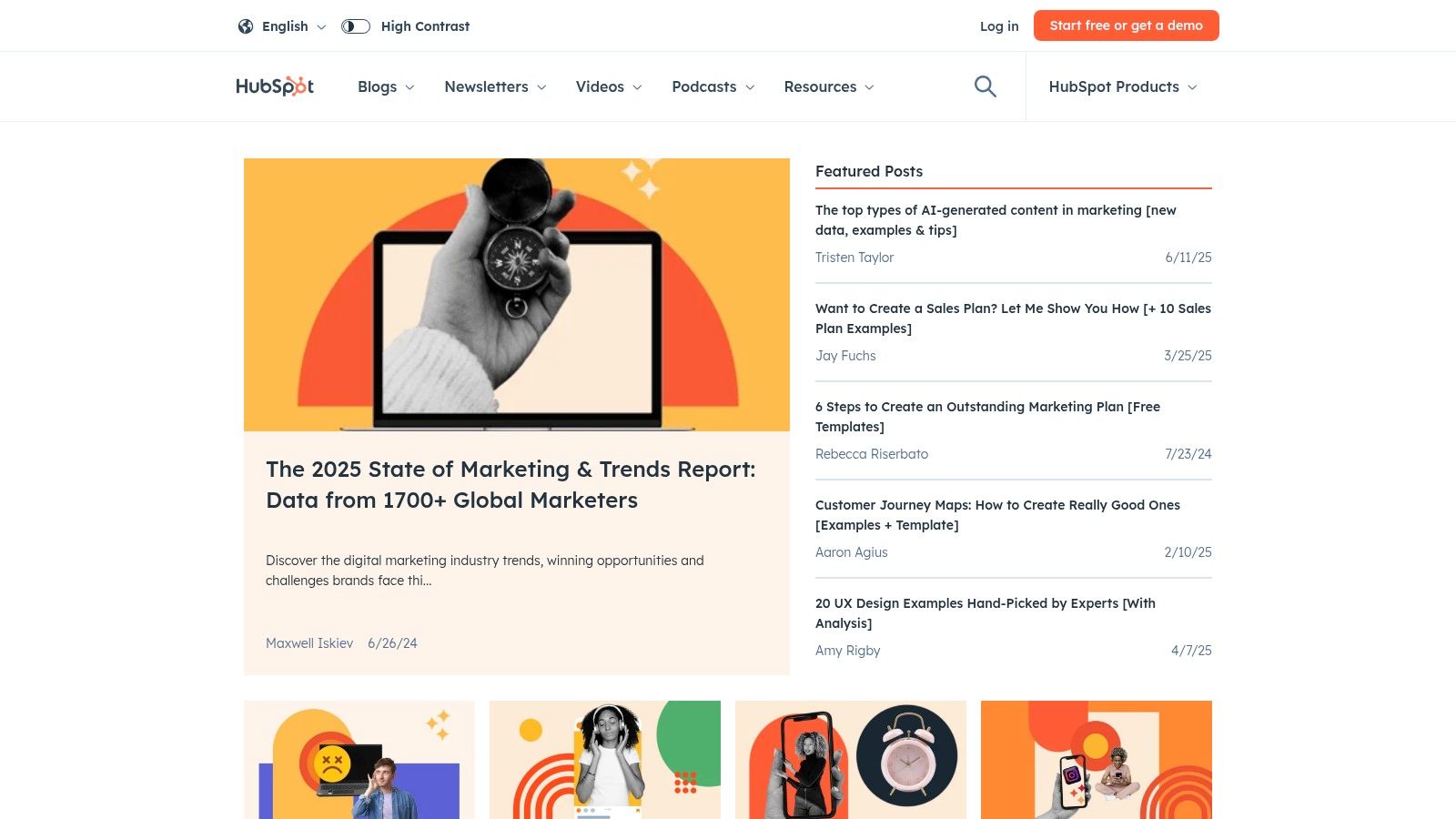
This platform excels by offering more than just theory. Each example, from Disney to Starbucks, is dissected to reveal the underlying tactics and channel integrations. It’s this focus on actionable insight that makes the HubSpot Blog a superior resource for e-commerce owners, marketing managers, and digital agencies alike.
HubSpot's content is meticulously structured for learning and application. The user experience is clean and intuitive, ensuring readers can easily navigate the extensive information without feeling overwhelmed.
- In-Depth Analysis: The blog provides detailed breakdowns of 15 distinct omnichannel campaigns, explaining the "how" and "why" behind their success.
- Actionable Takeaways: Each case study concludes with practical tips that businesses can directly apply to their own strategies.
- Free Access: Unlike gated content or paid courses, HubSpot's comprehensive guides are available for free, requiring no registration. This removes barriers for teams of all sizes.
The HubSpot Blog earns its top spot because it serves as both a library and a launchpad. It provides the foundational knowledge and real-world proof needed to build a compelling business case for omnichannel adoption. While some of the content naturally promotes HubSpot's software, the educational value remains exceptionally high and objective. For those inspired by these examples, understanding the role of a unified communication hub is a logical next step. You can delve deeper into how a customer communication platform forms the backbone of these strategies. This resource is perfect for teams ready to move from theory to implementation.
For e-commerce and D2C brands looking for a practical, get-started-now guide, the Omnisend Blog offers an excellent resource. Their article, "What is Omnichannel Marketing? Examples, Tips & Tools," strikes a perfect balance between clear definitions, real-world examples, and actionable tool recommendations. This approach makes it ideal for marketing managers and store owners who need to quickly grasp the core concepts and see a direct path to implementation.
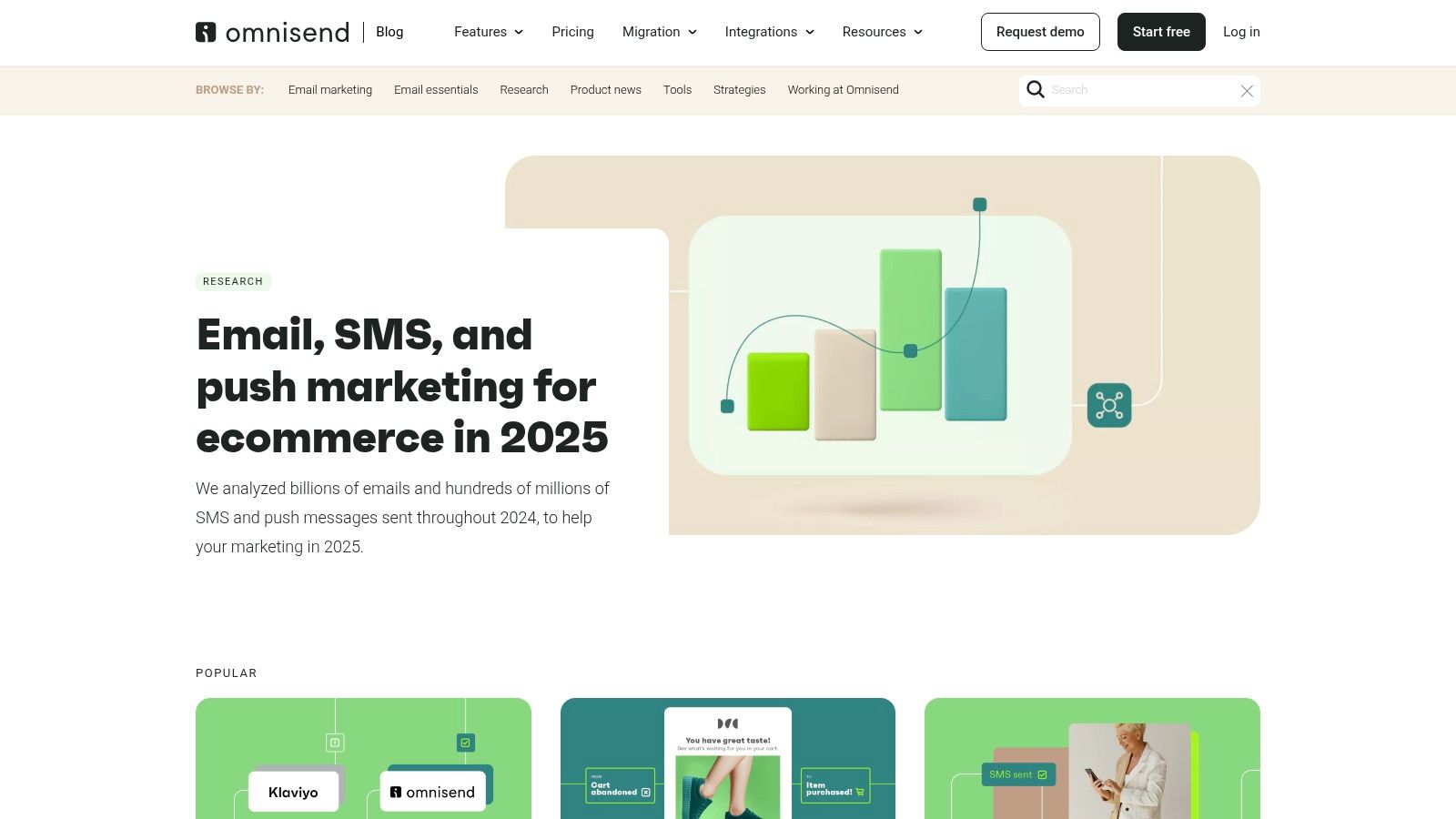
Unlike academically dense resources, Omnisend focuses on concise and accessible guidance. It presents powerful omnichannel marketing examples without overwhelming the reader, ensuring the information is digestible and immediately useful. The user experience on the blog is straightforward, prioritizing clarity and speed to help busy professionals find the answers they need efficiently.
Omnisend’s content is tailored for action. It’s designed not just to inform but to equip readers with the knowledge and tools necessary to launch their own omnichannel initiatives.
- Clear Definitions: The article excels at explaining the difference between multichannel and omnichannel marketing, a crucial distinction for building an effective strategy.
- Practical Examples: It showcases successful campaigns from brands that have mastered the omnichannel approach, providing concrete proof of its impact.
- Tool Recommendations: Uniquely, it suggests specific tools to help implement these strategies, bridging the gap between theory and execution.
- Free Access: All this valuable content is available for free without any registration, making it accessible to businesses of all sizes.
The Omnisend Blog earns its place by being exceptionally pragmatic. It serves as a launchpad for businesses ready to move beyond basic marketing and into a more integrated customer experience. While the content naturally aligns with Omnisend's platform, the educational value is high and the advice is broadly applicable. The focus on implementation makes it a great follow-up for those who understand the "what" and are now asking "how." This resource pairs well with further reading on how multi-channel marketing automation serves as the engine for these coordinated efforts. It is perfect for teams who want clear, concise guidance to begin their omnichannel journey.
For teams moving from inspiration to implementation, selecting the right technology stack is a critical next step. TechRadar’s guide, "Best Content Marketing Tools of 2025," serves as a vital resource for evaluating the software that powers sophisticated omnichannel marketing examples. Instead of showcasing campaigns, it focuses on the operational backbone, providing expert reviews and comparisons of tools designed to manage content across multiple channels seamlessly. This makes it an essential bookmark for decision-makers tasked with building a capable marketing infrastructure.
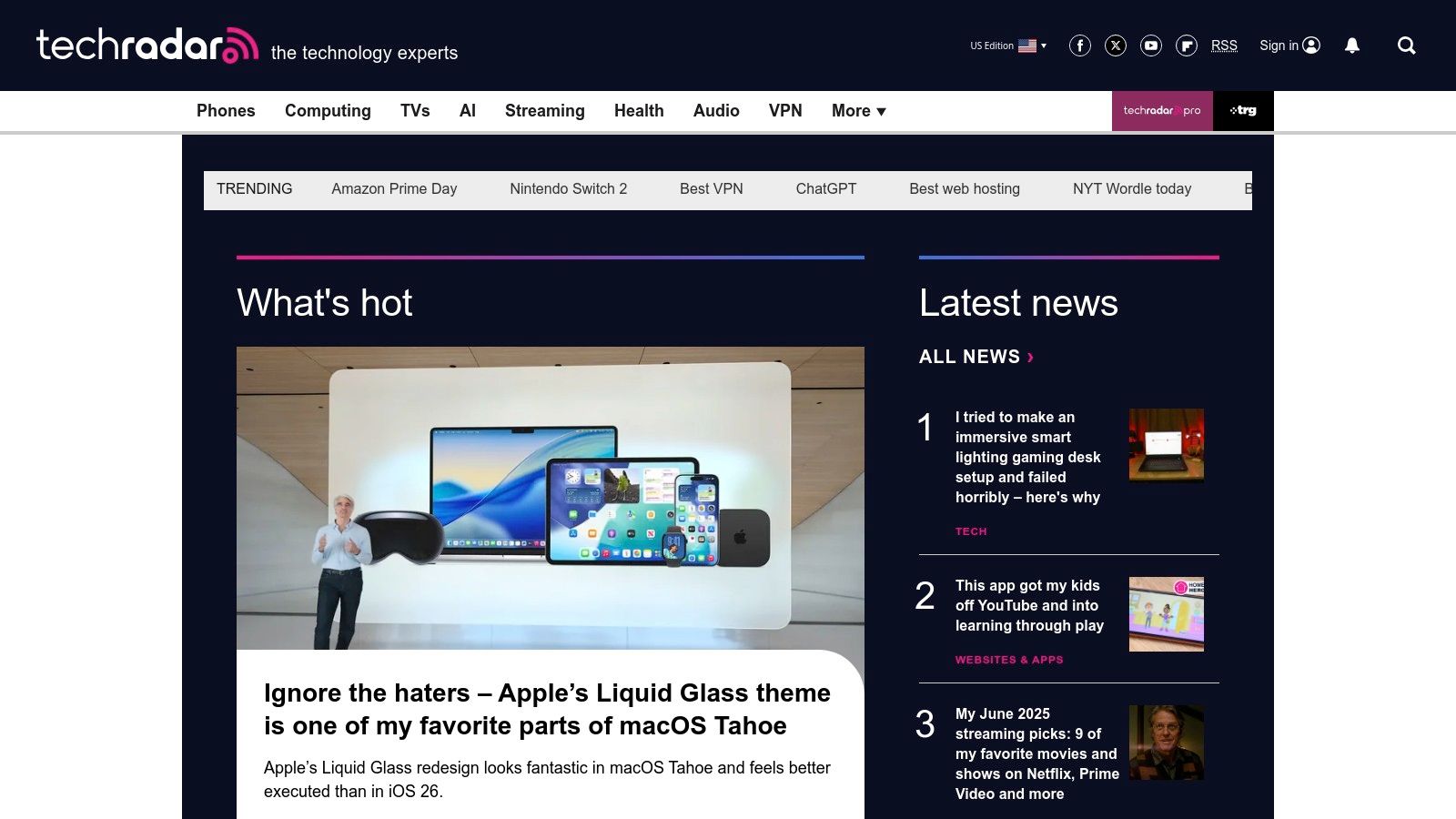
This platform excels by offering unbiased, in-depth analysis from technology experts. While many review sites can feel promotional, TechRadar maintains a critical perspective, helping marketing managers, agency consultants, and e-commerce owners make informed purchasing decisions. It translates complex technical features into practical benefits, connecting software capabilities directly to omnichannel strategy execution.
TechRadar’s content is structured to facilitate quick yet thorough comparisons. The user experience is clean, with clear sections for features, pricing, and verdicts, allowing readers to efficiently vet multiple platforms without getting lost in technical jargon.
- Expert Reviews: The guide offers detailed evaluations of leading content marketing tools, many of which are central to executing an omnichannel approach.
- Comparative Analysis: By presenting pros, cons, and key features side-by-side, the platform simplifies the complex decision-making process for new software adoption.
- Free Access to Information: All expert reviews and comparisons are available for free, providing immense value without a subscription fee. This is a significant advantage for teams on a tight budget.
TechRadar earns its spot by bridging the gap between strategy and technology. After studying successful omnichannel marketing examples, the logical next question is, "What tools do we need to do this?" This guide provides the answer. While it requires time to read through multiple reviews, the depth of insight ensures a well-informed investment. The platform is perfect for teams ready to equip themselves with the software needed to unify their customer communications and content delivery across all touchpoints.
For businesses ready to move from studying examples to selecting the technology that powers them, the WebFX Blog offers a crucial next step. Its article, "Find the Omnichannel Marketing Platform Your Business Needs," shifts the focus from "what is it?" to "how do I build it?" This resource is invaluable for decision-makers tasked with choosing the right software stack to unify their customer experience across multiple touchpoints. It provides a clear, comparative look at the market's leading tools.
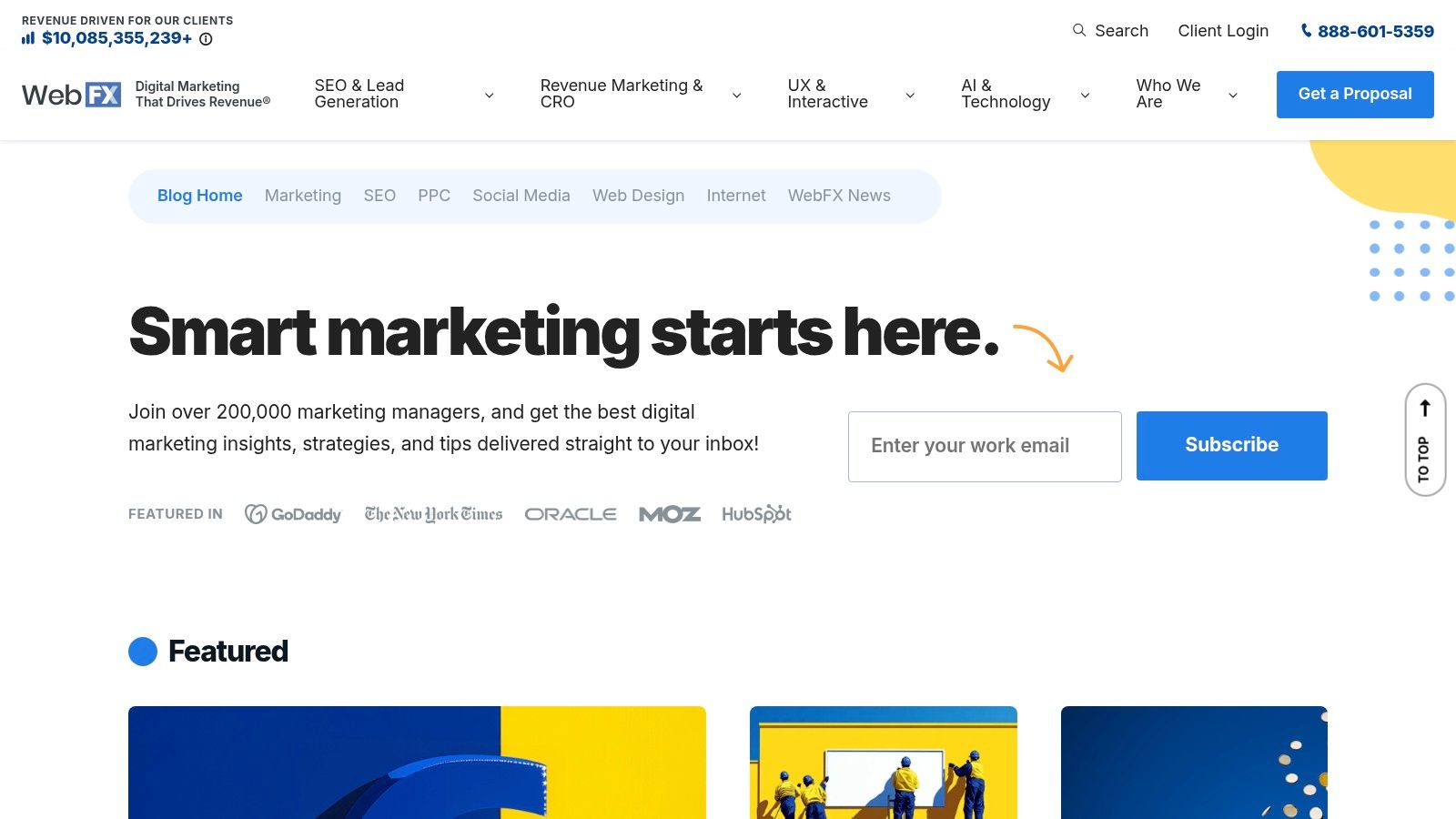
This platform excels by translating high-level strategy into a practical procurement process. Instead of just showcasing successful omnichannel marketing examples, it breaks down the platforms that make them possible. This makes the content highly relevant for marketing managers, e-commerce owners, and agency consultants who need to make informed technology investments.
WebFX structures its content to guide businesses through the complex platform selection process. The user experience is straightforward, presenting complex information in an easily digestible format that facilitates side-by-side comparisons.
- Platform Overviews: The article provides detailed reviews of top omnichannel marketing platforms, outlining their core functionalities and ideal use cases.
- Feature & Benefit Analysis: It highlights the key features and benefits of each software, helping readers match platform capabilities to specific business needs.
- Free, Unrestricted Access: Like other top resources on this list, the guide is completely free and requires no registration, making it accessible to any organization evaluating its tech stack.
The WebFX Blog earns its place by bridging the gap between inspiration and implementation. After learning from the omnichannel marketing examples provided by other resources, a business's natural next question is about the underlying technology. This article directly answers that question. While the content may implicitly favor platforms that align with WebFX's services, it remains a highly useful and objective starting point for research. It’s an essential read for any team looking to invest in the infrastructure needed to create a truly seamless customer journey.
For teams moving from inspiration to implementation, the MoEngage Blog provides a critical road map. While other resources focus on what omnichannel marketing looks like, MoEngage zeroes in on the "how," specifically guiding businesses through the complex process of selecting the right technology to power their strategy. Its article, "How to Choose an Omnichannel Marketing Platform," is a standout piece for its structured, practical approach to a pivotal business decision.
This resource is designed for marketing managers and digital agencies who are past the "why" and are now tackling the "with what." It demystifies the platform selection process by providing clear evaluation criteria, comparison frameworks, and actionable tips. This focus on the technological backbone of omnichannel marketing examples makes the MoEngage Blog an invaluable tool for ensuring a successful, long-term implementation.
MoEngage presents its content in a clear, well-structured format that helps leaders make informed decisions. The user experience is clean, allowing for easy absorption of detailed technical and strategic information without friction.
- Platform Evaluation Criteria: The blog offers a comprehensive checklist for assessing potential omnichannel marketing platforms, covering everything from data integration to channel support.
- Implementation Guidance: It goes beyond selection, providing tips to ensure a smooth rollout and adoption of new marketing technology across the organization.
- Free Access: This high-value, strategic content is available for free, making it accessible to businesses of all sizes who are ready to invest in their marketing stack.
The MoEngage Blog earns its spot by bridging the gap between strategy and execution. It acknowledges that even the best omnichannel ideas will fail without the right underlying technology. While some content may naturally highlight MoEngage's own services, the educational value in its platform-agnostic evaluation advice is immense. For businesses looking to integrate powerful channels like messaging apps, understanding these platform capabilities is key. You can explore how channels like WhatsApp Marketing Automation fit into a larger platform strategy. This resource is perfect for teams ready to build the engine that drives their omnichannel vision.
For e-commerce owners and marketers who need to move beyond theory and into tactical execution, the Barilliance Blog offers a masterclass in strategy. Its article, "17 Omnichannel Strategies and Tactics Breakdown," serves as a detailed playbook, dissecting numerous real-world campaigns to reveal the specific tactics that drive success. This resource is particularly valuable for its granular focus on the "how" of omnichannel implementation, making it an excellent source for those seeking practical, proven ideas.
The platform shines by presenting a diverse range of omnichannel marketing examples, from well-known giants to smaller, innovative brands. Each example is analyzed not just for its high-level strategy but for the specific tools and channel integrations used. This focus on tactical breakdown makes the Barilliance Blog a go-to resource for marketing managers and digital agencies looking for inspiration backed by clear, actionable steps.
Barilliance structures its content for immediate application, providing a dense but highly organized collection of strategies. The user experience is straightforward, allowing readers to easily digest the wealth of information and identify tactics relevant to their own business context.
- Diverse Strategy Breakdown: The article details 17 distinct omnichannel strategies, offering a broad spectrum of ideas suitable for various business models and industries.
- Real-World Case Studies: Each strategy is supported by real company examples, illustrating how the tactics work in a live market environment.
- Free and Open Access: The content is available for free without any registration requirements, ensuring that teams of any size can access these valuable insights without barriers.
The Barilliance Blog earns its place by acting as a tactical encyclopedia for omnichannel marketing. It provides the specific, detailed examples needed to build a robust and multi-faceted strategy. While the content is dense and requires focused attention, its value lies in its depth and practicality. It effectively bridges the gap between understanding the concept of omnichannel and knowing which specific tactics to deploy. This resource is ideal for teams who have grasped the "why" and are now ready to master the "how" of creating seamless customer journeys.
For those who learn best through proven results and financial impact, ROI Advisers offers a focused look at high-stakes omnichannel marketing examples. Their article, "6 Most Successful Omnichannel Marketing Case Studies," cuts straight to the core of what makes a campaign profitable. It’s an excellent resource for leaders and managers who need to justify their marketing spend and understand the direct financial outcomes of a well-executed strategy.
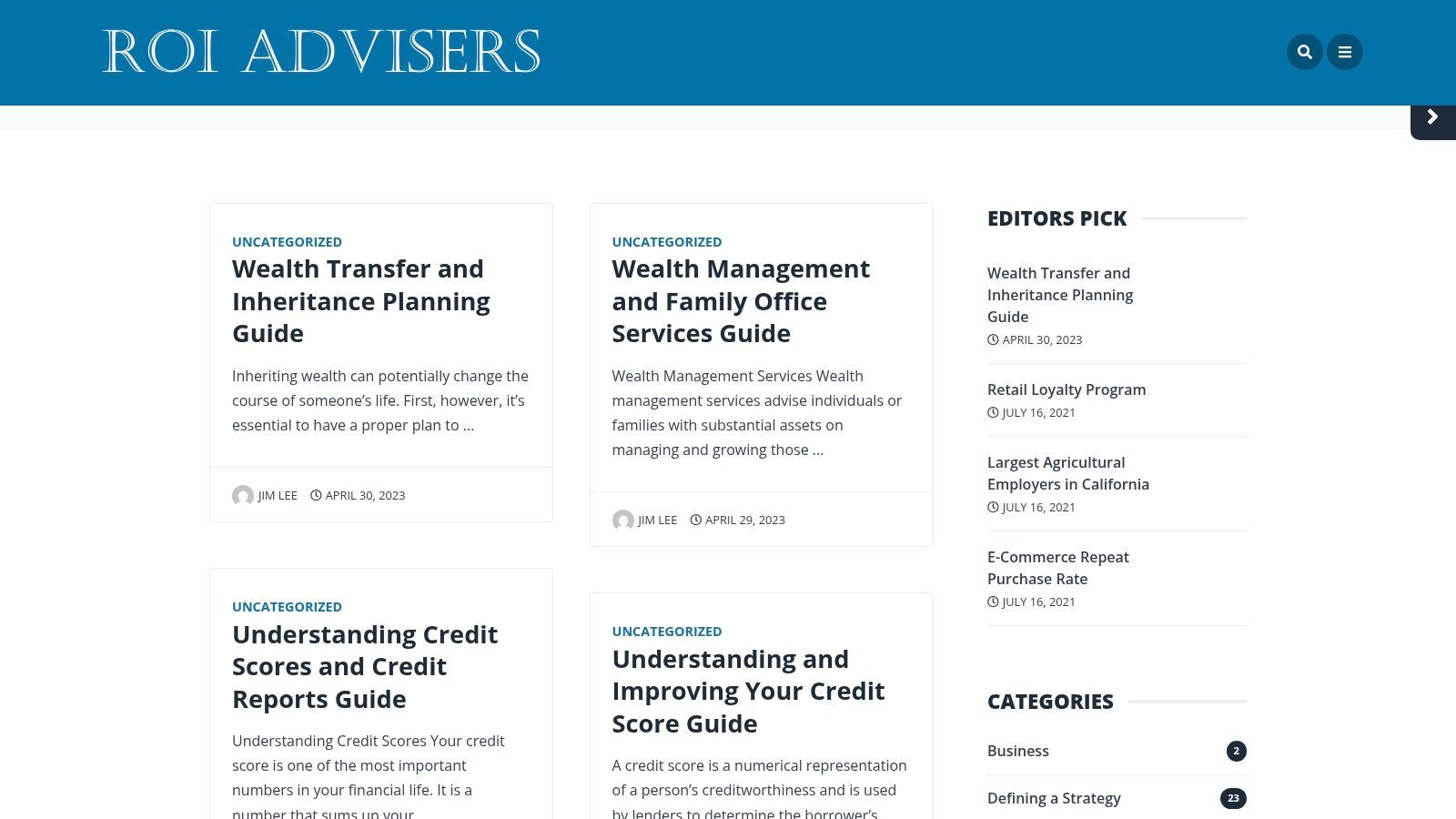
This platform distinguishes itself by emphasizing the "ROI" aspect of omnichannel marketing. It moves beyond brand experience to analyze how integrated channels contribute to tangible business growth. This makes it particularly valuable for agencies and consultants aiming to demonstrate concrete value to their clients. Of course, a key part of this is knowing how to calculate SEO ROI effectively to prove the success of your digital efforts.
ROI Advisers presents its case studies in a clear, concise format that prioritizes lessons learned. The user experience is straightforward, allowing readers to quickly absorb the key takeaways from each real-world example.
- Detailed Case Studies: The article provides a deep dive into six distinct omnichannel campaigns, analyzing their strategies and measurable outcomes.
- Actionable Lessons: Each case study concludes with clear "lessons learned," offering practical wisdom that can be applied to other businesses.
- Free Access: The content is available for free without any registration or paywall, making these powerful insights accessible to all.
ROI Advisers earns its place by delivering exactly what its name promises: advice centered on return on investment. While the selection of case studies is smaller than some other resources, the depth and focus on financial success provide a unique and critical perspective. It’s an ideal read for anyone who needs to build a business case for an omnichannel strategy based on proven financial wins rather than just marketing theory. This resource is perfect for results-driven teams who want to see the numbers behind the strategy.
Source 🔄 Implementation Complexity ⚡ Resource Requirements 📊 Expected Outcomes 💡 Ideal Use Cases ⭐ Key Advantages HubSpot Blog Medium - requires time to read and digest Moderate - no registration needed High - practical insights with case studies Users wanting actionable real-world omnichannel examples Free, regularly updated, user-friendly interface Omnisend Blog Low - concise and easy to understand Low - free access, no registration Medium - practical tips and real-life examples Readers seeking quick guidance and tools tips Clear explanations, actionable tips TechRadar Medium-High - requires reading multiple reviews Moderate - in-depth tool evaluations High - expert tool reviews aiding decisions Users looking for expert tool reviews and comparisons Expert reviews, regularly updated WebFX Blog Medium - covers platform comparison and selection Moderate - no registration needed High - helps selecting suitable platforms Businesses comparing omnichannel marketing platforms Comprehensive content, platform comparisons MoEngage Blog Medium-High - detailed evaluation and tips Moderate - no registration needed High - structured guidance on selection and implementation Those needing structured platform selection guidance Detailed, well-structured, actionable advice Barilliance Blog High - dense, in-depth case analyses Moderate - free access High - deep understanding of diverse strategies Users wanting extensive omnichannel strategy analysis In-depth strategy breakdowns, practical takeaways ROI Advisers Medium - focused on few detailed case studies Low - free access Medium - real-world insights and lessons Understanding practical applications of successful campaigns Real-world examples, practical lessons
The powerful omnichannel marketing examples we've explored, from Nike’s integrated app ecosystem to Disney's seamless park experience, share a foundational philosophy: customer-centricity is non-negotiable. They have moved beyond simply being present on multiple channels. Instead, they have engineered a unified, intelligent system where each touchpoint is a continuation of a single, cohesive brand conversation.
The goal is to dissolve the boundaries between your website, social media DMs, mobile app, and physical stores. This creates a frictionless journey that feels intuitive and personal to the customer. True omnichannel excellence is not about shouting your message from every platform; it's about being a single, helpful entity everywhere your customer chooses to be.
While the scale of these campaigns might seem daunting, the underlying strategies are surprisingly accessible. The common threads weaving through these success stories provide a clear blueprint for your own efforts.
- Journey Mapping is Essential: The first step is always to understand the customer. Map out their typical journey and identify the points of friction. Where do they get stuck? Where do you see the most significant drop-off? These pain points are your opportunities.
- Data Unification is Power: A fragmented view of the customer leads to a fragmented experience. The best omnichannel strategies are built on a centralized data platform that provides a single source of truth for every customer interaction, regardless of the channel.
- Personalization Drives Connection: Generic, one-size-fits-all messaging fails in an omnichannel world. Success hinges on using customer data to deliver relevant content, offers, and support at the right moment in their journey.
Translating these insights into action requires a focused, step-by-step approach. Don't try to boil the ocean. Start small, prove the concept, and scale what works.
- Start with Your Highest-Impact Channels: You don't need to be everywhere at once. Identify the 2-3 channels where your customers are most active and where communication breakdowns are most common. Focus on integrating these first.
- Choose the Right Technology Stack: Implementing these strategies manually is nearly impossible. You need a platform that can unify conversations and data. When selecting a tool, consider its ability to integrate with your existing systems, its user interface for your team, and its capacity to scale as you grow. Look for solutions that centralize communication from key touchpoints like Instagram DMs, WhatsApp, and website chat.
- Empower Your Team: An omnichannel strategy is as much about people as it is about technology. Ensure your customer support and marketing teams are equipped with the right tools and training. Provide them with a complete view of the customer's history so they can offer informed, consistent, and personalized support.
The journey from siloed channels to a unified omnichannel engine is a marathon, not a sprint. The most successful omnichannel marketing examples show us that continuous improvement, driven by data and a deep understanding of customer needs, is the key to building lasting loyalty and driving sustainable growth. The future belongs to brands that are not just present everywhere but are seamlessly one everywhere.
Ready to unify your customer conversations and turn powerful examples into your reality? See how Spur centralizes your communications from every channel into one smart inbox, empowering your team to deliver the seamless experience your customers expect. Explore Spur today and start building your own omnichannel success story.
